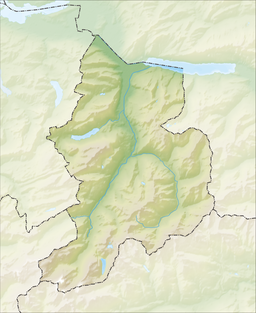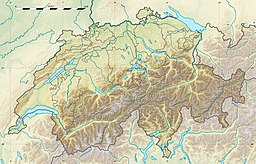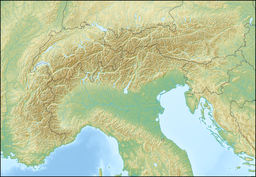|
Walensee
Lake Walen, also known as Lake Walenstadt or Walensee (German pronunciation: [ˈvaːln̩ˌzeː] ⓘ), is one of the larger lakes in Switzerland. Located in the east of the country, about two thirds of its area are in the canton of St. Gallen and about one third in the canton of Glarus. Its name means 'Lake of the Walhaz' (German: See der Welschen), since in the early Middle Ages Lake Walen formed the linguistic border between the Alemanni, who settled in the west, and the Romansh people, the Walhaz (Welschen), in the east.[1] GeographyThe lake lies in a valley between the Appenzell Alps to the north and the Glarus Alps to the south. It has a long east-west extension but is relatively narrow in north-south direction, with a surface area of 24 km2 (9.3 sq mi). It has a maximum depth of 151 m (495 ft). The three main tributaries of the lake are the Seez, Murgbach and Linth. The latter continues its course from Walensee to Obersee (Lake Zurich) through the Linth canal. Until the regulation of the Linth during the early 19th century, the Linth bypassed Walensee west of it and the lake's outflow was a river called the Maag, which merged with the Linth near Ziegelbrücke. The Seerenbach Falls and Rinquelle are adjacent to the north of the lake. The Schnittlauchinsel, near the eastern end of the lake, is the only island in the Walensee. The Churfirsten range raises steeply on the north side from the lake's level at 419 m (1,375 ft) to 2,306 m (7,566 ft) above sea level, joining the Mattstock (1,936 m (6,352 ft)) and Federispitz (1,865 m (6,119 ft)) to the west. The Paxmal near Walenstadt overlooks the lake. On the south, the lake is overlooked by the Mürtschenstock Massif, whose peak is 2,441 m (8,009 ft) above sea level, and the resort area Flumserberg. The highest point of the lake's drainage basin is the Tödi (3,614 m (11,857 ft)).[2] As seen from the Flumserberg Settlements and transportationApart from Walenstadt at the eastern end of the lake, other lakeside towns and villages are Weesen at the western end of the lake and Mühlehorn and Mols, Murg and Unterterzen south of the lake. Quinten, located on the northern shore of the lake, can only be reached on foot from Weesen or Walenstadt via a hiking trail[3] or by boat (e.g. via a ferry from Murg) as there are no roads. Commercial passenger boats are operated by Walensee-Schifffahrt.[4] To the south, the lake is followed by the A3 motorway and the Ziegelbrücke–Sargans railway line. There is also a continuous bike route along the southern shore. Unterterzen railway station is connected via a gondola lift with Oberterzen and the resort area Flumserberg.[5] ArtsThe lake provided the inspiration for a solo piano piece by Hungarian Romantic composer Franz Liszt, Au lac de Wallenstadt. The piece is part of a collection of solo piano works inspired by his travels to Switzerland in the 1830s. Gallery
See alsoReferences
External links
|
||||||||||||||||||||||||||||||||||||||||||














